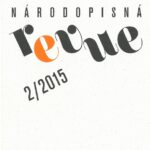Journal of Ethnology 2/2015 deals with the theme Ethnologic Aspects of Adornment. In her study, Alena Dunajová pays attention to decoration of rural houses, especially on selected Moravian examples (Ars una, species mille. The form changes but the purpose remains – decoration of rural houses in the 19th and 20th century). Barbora Půtová writes about body adornments and their functions on examples of foot binding of young girls in Chinese culture, optical lengthening of women’s necks in the Kayan ethnic group and lip-plates inserting into women’s lips in the Mursi tribe.(The Relativity and Variability of Female Body Adornment). Martin Soukup introduces the theme of penis sheaths in New Guinea (Culture on Foreskin: New Guinea variations on fig leave). In his study, Petr Lozoviuk goes beyond the specified theme and writes about discussions regarding the national character of so-called Czech lands folk culture (Ethnography and Disputes about Ethnocultural Interpretation of “Folk Culture”).
Transforming Tradition column presents a text by Jana Poláková about the renewed Carnival procession in Opatovice near Rajhrad. Review Section publishes the Miloš Melzer´s memory of ethnographer Jan R. Bečák (1915–1987). Social Chronicle remembers anniversaries of Vítězslav Štajnochr (born 1945), an art historian and ethnologist; Vlastimil Vondruška (born 1955), an ethnologist, historian and writer; ethnologist Magdaléna Rychlíková (born 1955) and ethnologist Alena Vondrušková (born 1955). Other regular columns publish reports from exhibitions and festivals, reviews of new books and other news from the branch.
Ars una, species mille. The form changes but the purpose remains – decoration of rural houses in the 19th and 20th century
In connection with contemporary graphic expressions on village buildings we often point out the alleged loss of builders´ taste. The author proceeds from the so-called René Girard mimetic theory as a deciding influence on human cultural expressions. On many examples she documents the endeavour of the then builders to imitate some impressive and prestigious models and by appropriating them to get or demonstrate their social dominance. She compares the phenomenon of the so-called rural Baroque (country houses with gable walls imitating the Baroque style in Southern Bohemia) with the contemporary expressions of the so-called entrepreneurs´ Baroque. Especially on examples from Moravia she documents different forms and places where the decoration was used (it is used even today in some locations) – decors pressed into wet plaster, patterns scraped into hard plaster, decorative burnt bricks etc. She states a significant role of monument preservation for the protection of cultural monuments that by conservation of the survived condition enables the tangible proves to survive on the one side, on the other one, however, it steps in the process of local traditions in an unnatural way.
The Relativity and Variability of Female Body Adornment
The subject of the paper is a comparative analysis of the relation between a culturally conditioned physical modification of the female body and its aesthetic and socio-cultural function in the life of three selected cultures. The phenomenon of adornment is analysed in the context of the social status of women, local myths and cultural traditions. Specific manifestations of body adornment and its variability are presented as a means contributing to the functioning of the society, integrity of cultural traditions and demonstration of the social status of members of a given society. Adornment and its function in the society are researched on the examples of foot binding of young girls in the traditional Chinese culture, optical lengthening of women’s necks in the Kayan ethnic group and lip-plates inserting into women’s lips in the Mursi tribe. When analysing the adornment connected with women´s physical suffering we also pay attention to its relativity when considered from the gender perspective. Different aspects of adornment are mapped in specific cultural and historic context on the background of values and standards of the researched cultures.
Culture on Foreskin: New Guinea variations on fig leave
The study deals with the analysis of penis sheaths the New Guinea men used to wear. The artefact was understood to be just a part of attire in some cultures, in other ones it was connected with initiations or worn solely on special occasions. The text presents the voluminous spectrum of materials the penis sheaths used to be made from, as well as the variety of occasions on which it used to be worn. Following cultural contacts and especially by the influence of missionaries and colonial administrations, the New Guinea men gradually stopped wearing the penis sheaths. The penis sheaths became a symbol of “primitiveness” based on which the colonial administrations and governments built their development and administrative projects. Nowadays, especially tourists desire to see the primitive New Guinea represented by a picture of the New Guinea man wearing the penis sheath. This has become a souvenir which can be bought in holiday resorts, at the airports or local markets. At present, penis sheaths are worn rather exceptionally in Papua-New Guinea, usually on festive occasions and as a part of cultural shows. In the part of New Guinea that belongs to Indonesia, penis sheaths are worn either in regions much-sought-for by tourists, or as a political protest.
Ethnography and Disputes about Ethnocultural Interpretation of “Folk Culture”
The study is devoted to the idea background to the discussions about the national character of so-called folk culture of the Czech lands inhabitants. On analysed examples from Western Bohemia, the ethno-cultural ambivalence of local ethnographic facts is thematised and the national and political tools of the discussions regarding their ethnic origin is explained. In this connection, the ethnography of that time is interpreted a “national science” that had a specific task consisting in the explication of national particularity. The author makes a conclusion that to recognize the “Slavonic” or the “German” feature of particular cultural artefacts or even larger cultural systems in the ethnographic production of that time was rather an ideological wish of the given interpreter than a scientific reflexion.



